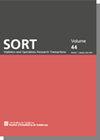利用跨栏模型对暖期持续时间序列进行统计建模
IF 1.2
4区 数学
Q4 OPERATIONS RESEARCH & MANAGEMENT SCIENCE
Sort-Statistics and Operations Research Transactions
Pub Date : 2017-06-21
DOI:10.2436/20.8080.02.57
引用次数: 2
摘要
计数的回归模型可以应用于地球科学,例如在研究极端气候数量的趋势时。障碍模型是一种改进的计数模型,可以看作是分布的混合。本文采用障碍模型来模拟高温周期长度的总和。提出了对文献中常见版本的修改,因为需要左截断以及对零的特殊处理。该模型的结果与简单计数模型的结果进行了比较。本文章由计算机程序翻译,如有差异,请以英文原文为准。
Statistical modeling of warm-spell duration series using hurdle models
Regression models for counts could be applied to the earth sciences, for instance when studying trends of extremes of climatological quantities. Hurdle models are modified count models which can be regarded as mixtures of distributions. In this paper, hurdle models are applied to model the sums of lengths of periods of high temperatures. A modification to the common versions presented in the literature is presented, as left truncation as well as a particular treatment of zeros is needed for the problem. The outcome of the model is compared to those of simpler count models.
求助全文
通过发布文献求助,成功后即可免费获取论文全文。
去求助
来源期刊

Sort-Statistics and Operations Research Transactions
管理科学-统计学与概率论
CiteScore
3.10
自引率
0.00%
发文量
0
审稿时长
>12 weeks
期刊介绍:
SORT (Statistics and Operations Research Transactions) —formerly Qüestiió— is an international journal launched in 2003. It is published twice-yearly, in English, by the Statistical Institute of Catalonia (Idescat). The journal is co-edited by the Universitat Politècnica de Catalunya, Universitat de Barcelona, Universitat Autonòma de Barcelona, Universitat de Girona, Universitat Pompeu Fabra i Universitat de Lleida, with the co-operation of the Spanish Section of the International Biometric Society and the Catalan Statistical Society. SORT promotes the publication of original articles of a methodological or applied nature or motivated by an applied problem in statistics, operations research, official statistics or biometrics as well as book reviews. We encourage authors to include an example of a real data set in their manuscripts.
 求助内容:
求助内容: 应助结果提醒方式:
应助结果提醒方式:


